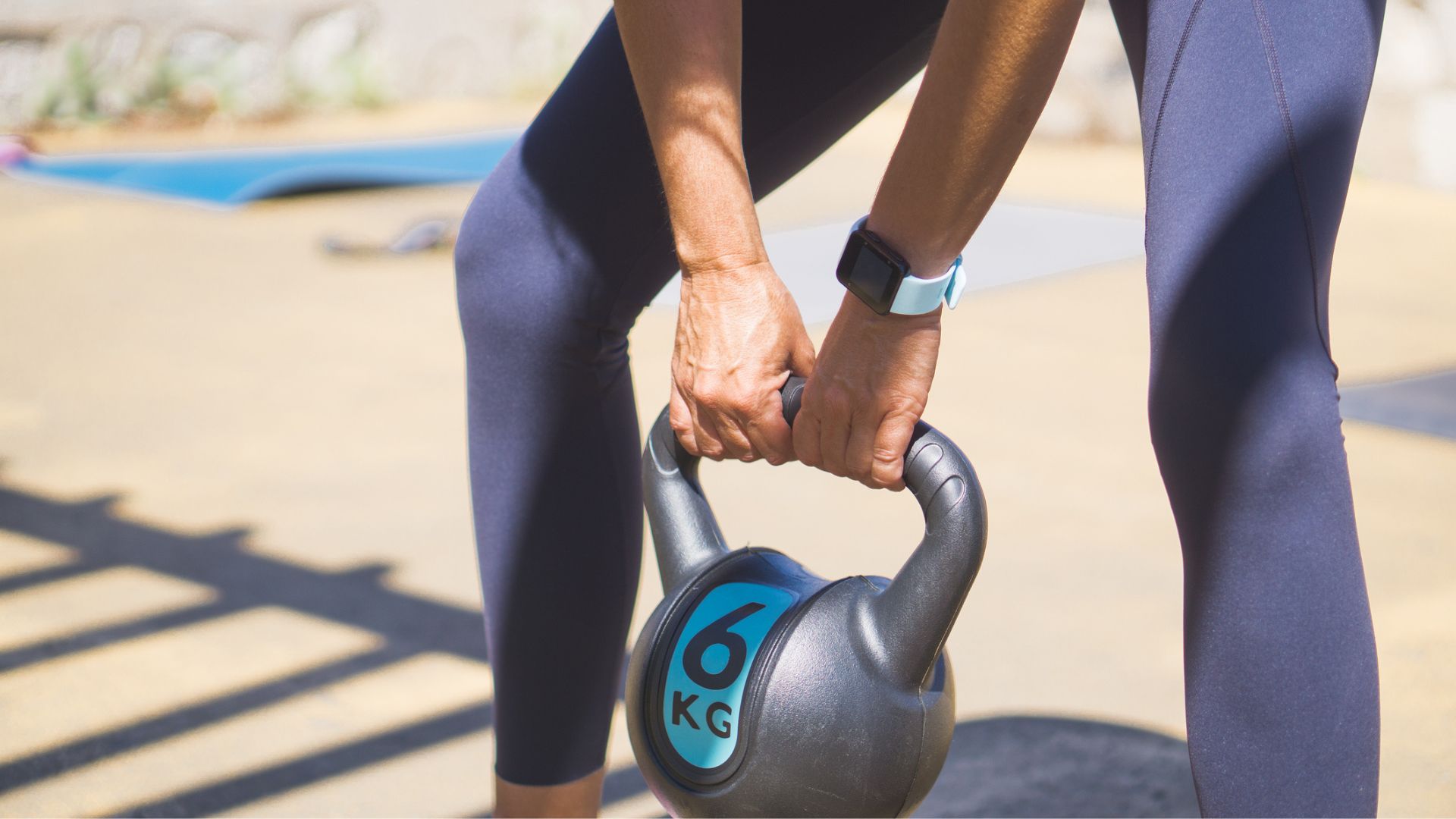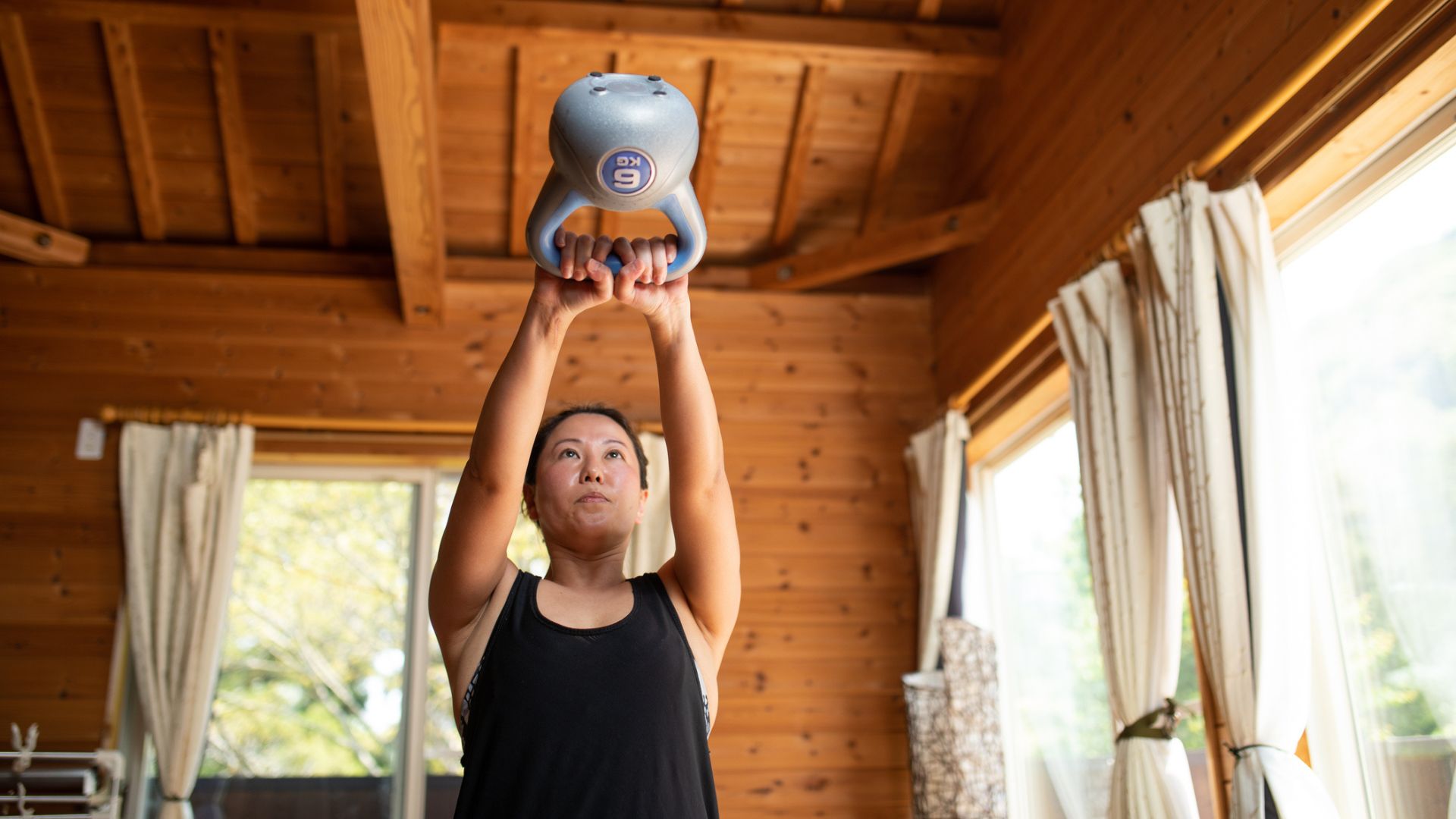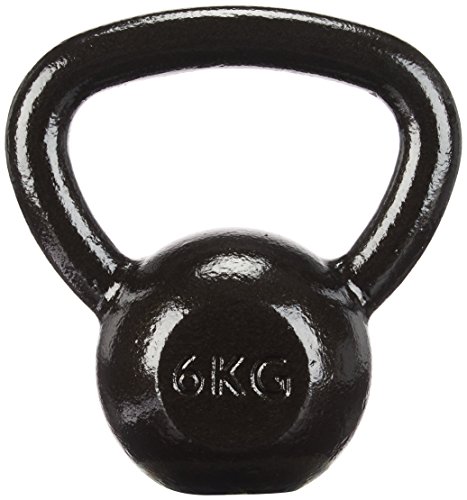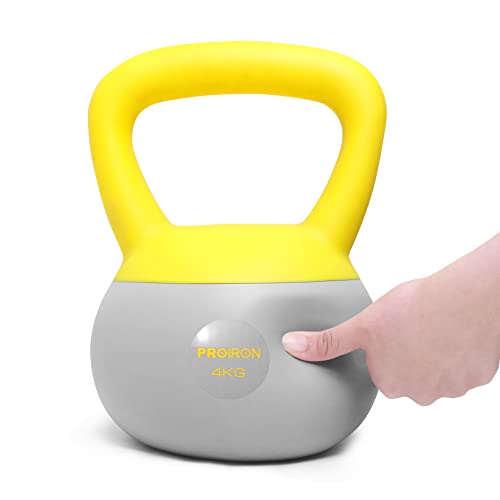
As woman&home's digital health editor and a certified fitness instructor, I'm a big fan of a kettlebell workout for beginners. If you're new to exercise or coming back after a break, these are some of the best weights to use.
A pick of the best kettlebells can help transform your strength training routine as much as any gym membership. With just a couple of exercises, you can target your entire body, boosting or maintaining muscle mass, core strength, grip strength, stability, and power. The weights are widely available to buy these days and easy to store too, making them perfect for home use.
Here, I've consulted expert personal trainers to create a full-body kettlebell workout for beginners. There are five exercises in total. To see improvements in your strength and muscle mass, aim for 12 to 15 reps and three sets.
Kettlebell workout for beginners
1. Kettlebell squat
A kettlebell squat can help boost strength in your upper and lower body as you work against the weight's resistance in your legs and glutes, and work to keep the weight stable using your arms, shoulders, and back.
"As you get stronger in these, you can flip the kettlebell upside down and hold in a ’goblet’ position in front of your chest, this will be more challenging for your core," says Emma Simarro, a personal trainer and the founder of Building Body Confidence.
But to start with, follow these instructions:
- Hold the kettlebell down in front of you with straight arms and close to the body.
- Squat down, dropping your bum to your heels, and the kettlebell will lower towards the floor.
- When you are deep enough in the squat (typically we aim for our thighs to be parallel to the floor), stand back to your starting position.
2. Overhead press
An overhead press works the arm muscles, upper back, and shoulders. It's a great catch-all upper-body exercise to do with a kettlebell, as the wider handle makes for a stable grip.
Start with a weight and feels manageable as you'll be lifting this above your head and follow these steps:
- Standing up straight, shoulders back and down, hold a kettlebell securely against your shoulder with one hand.
- Keep your elbow towards your ribcage, your forearm perpendicular to the ground, and try to engage your shoulder blade muscle.
- Keep tension in your wrist but allow some flexibility.
- Engage your core and glutes.
- Press the weight up directly over your head, before carefully bringing it back down to the starting position.
- As you do more reps and get tired, if you need to jump a little to lift the kettlebell above your head, that's fine.
If you feel a little unstable in this exercise, you could always practice with one of the best dumbbells and do a dumbbell workout for beginners - or use one of the best resistance bands. These tend to be lighter and you'll have more natural stability using them, allowing you to get comfortable in the movement before progressing to a kettlebell.
3. Kettlebell Romanian deadlift
Designed to exclusively target the lower body, a Romanian deadlift requires you to engage your leg muscles, glutes (buttocks), and brace your lower back, which helps improve core strength.
Here's how to do one with a kettlebell, per Simarro's guidance:
- Holding the kettlebell down in front of you, perform a ‘hinge’ action at the hips.
- Imagine you are pushing your hips back like you are shutting an open door behind you.
- Keep your back straight and soften your knees slightly (without squatting) to lengthen the hamstrings.
- When the kettlebell reaches mid-shin level (i.e. it doesn’t hit the floor), stop before returning to your starting position.

4. Kettlebell swing
Once you've mastered the kettlebell swing, it will be a go-to for kettlebell workouts at home and in the gym. It's a very useful, catch-all exercise, and one of the top core exercises to do at home, says Rachael Sacerdoti, a personal trainer, strength specialist, and founder of It's So Simple.
"This is one of the most effective exercises to build power, improve cardiovascular fitness, and strengthen your posterior chain (glutes, hamstrings, and lower back)," she explains.
Here's how to do one:
- Stand in front of the kettlebell hip-width apart.
- Bend down with a hip-hinge movement, grabbing hold of the kettlebell handle, with your shoulder blades back and down.
- Brace your core and lift up, allowing the kettlebell to swing back between your legs.
- Use your hips (not your arms or lower back) to drive the kettlebell forward, squeezing your glutes.
- Allow the kettlebell to come up to chest height.
- Remember to breathe as the exercise gets harder and keep your eyes looking forward.
5. Single arm row
Many people think a single arm row can only be done with a pick of the best dumbbells - but that's not the case, says Simarro. It's one of the best exercises to do in a kettlebell workout for beginners as it "works the back muscles, so it's great for your posture".
Follow these points in your routine - and remember to switch arms:
- Use a stool or chair for support, rest one hand on it and create a ‘square’ position with your body by keeping your spine flat.
- Hold the kettlebell in one hand and starting with a straight arm, pull it back towards your hip, maintaining a 90-degree angle at the elbow at the top of the exercise.
- Stop when you reach your hip and slowly return to the starting position.
Benefits of kettlebell workouts for beginners
- Kettlebells are versatile: "You can use them for many different exercises, which means your at-home workouts are varied and you can target the entire body," says Simarro.
- Kettlebells are easy to store: "Kettlebells are compact and don’t take up much space, which is ideal if you’re working out at home," says Sacerdoti.
- They are easy to use: "This makes kettlebells a great option for everybody, from beginners to more experienced trainers. You can also mix up your workouts, incorporating strength and conditioning," says Simarro.
- Kettlebells aren't as stable: That's good news for working the stabiliser muscles in the body. "They have to work harder to perform a kettlebell exercise," she says. Not sure you're ready for that yet? Weigh up dumbbells vs kettlebells.
- They can improve grip strength: Grip strength is an underrated test of fitness, with research finding it can be key predictor of all-cause mortality. A kettlebell workout can come in handy for improving this, says the personal trainer, as there are "different options for gripping".

A simple cast iron weight like this one from Amazon is perfect for doing a kettlebell workout for beginners. It's durable, easy to grip, and available in weights from 6kg to 20kg. They also have a low-key design that won't look out of place in your home.

Wooden floors and kettlebells don't tend to mix well. Typical cast iron kettlebells like the one above from Amazon are excellent for lifting but can bump your floors hard if you put them down heavy-handed. A kettlebell with a soft bottom, like this one from Amazon that ranges from 2 to 10kg, can give you peace of mind on wooden floor. They are also less likely to fall over.

The Decathlon 2-in-1 Double Kettlebell can save you space and money since you only need these two water bottle-style weights to lift from 2kg to 8kg in each hand. Fill the bottles to your desired weight and get strength training at home for beginners. These can also be screwed together using the fixtures on the base of the weights to create a barbell.
What weight kettlebell should a beginner use?
Weight is very relative as it depends on your starting fitness levels. You'll need two kettlebells for these exercises - a lighter one (between 2 and 8kg) and a heavier one (from 12kg).
If you pick up a lighter kettlebell and you find it's too easy, don't be concerned about making your workout harder. These exercises need to be challenging from the final repetition at least - otherwise, you'll struggle to see progress. Equally, if you pick up a kettlebell and it's too heavy, go down a weight. Using a kettlebell that's too heavy could result in injury.
You'll likely use the lighter kettlebell for upper-body workouts and the heavier kettlebell for lower-body movements like the deadlift and types of squats. While this isn't the case for every woman, we tend to use our legs more to support our weight and produce power (i.e. when walking or running) so our legs tend to be naturally stronger than our arms, back, and shoulders.
Is a 10-minute kettlebell workout enough?
Yes, if you only have 10 minutes every day or other day to work out, that's enough. Not only will you be able to gain and maintain muscle (provided you're continually making the workout harder for yourself), improve your strength, and boost your balance and stability, research from Brigham Young University shows that less than an hour a week of strength training can actually lower your biological age.
While the NHS recommends at least 150 minutes of moderate-intensity exercise every week to stay healthy and the study suggests a regular one-hour session three times a week is the best for longevity, doing a kettlebell workout for beginners - or any of the types of strength training - will have numerous benefits for your mental and physical health.
If you have any concerns about your ability to take part in exercise or want further guidance, speak to your GP.







